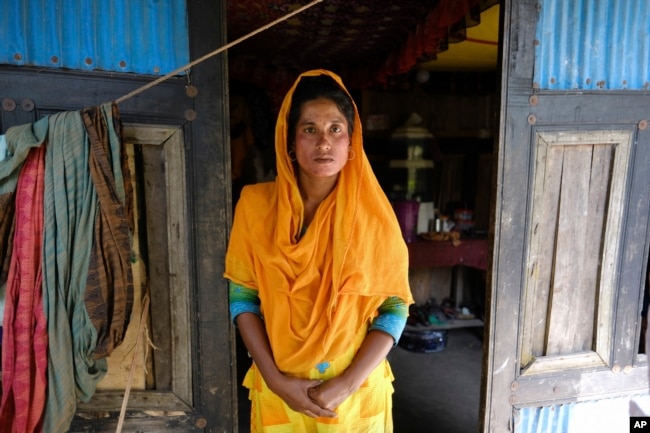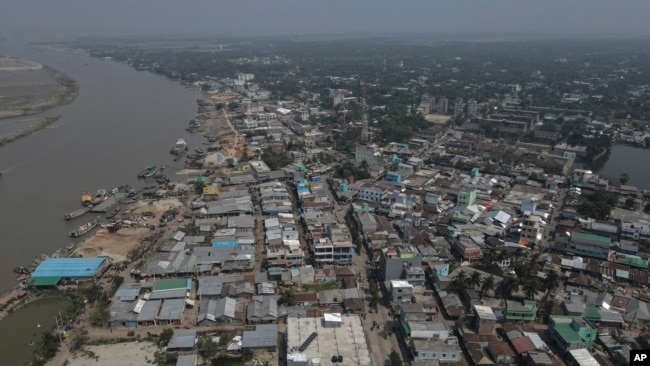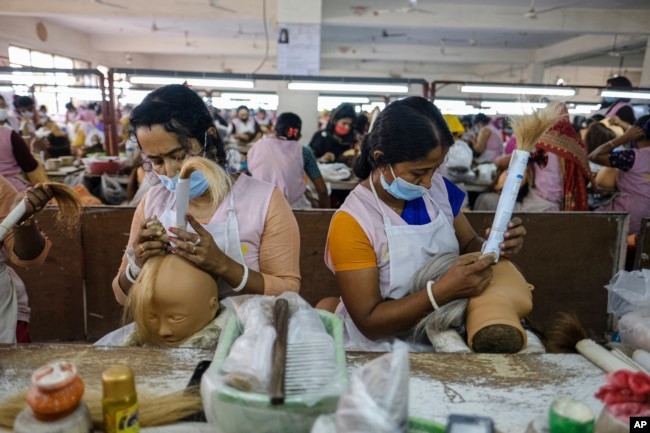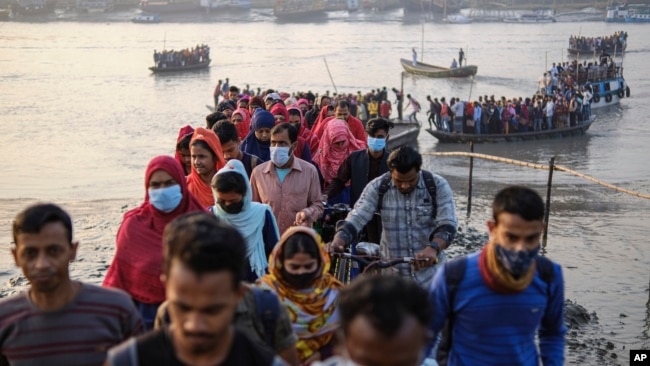”希望” 人は強いのです!!
どんな過酷な時でも、希望を持つことができる!!
思考が生み出す”希望”を!!
VOAで英語を学び、2050年気候問題を共に考えましょう!!
バングラデシュの街で見つけた気候変動難民の希望(和訳)
Climate Refugees Find Hope in Bangladesh Town
April 05,2022
バングラデシュの南西に位置する港町モングラには、数千人の難民が暮らしています。彼らは戦争や他の紛争から逃れてきたのではありません。気候変動による難民なのです。
モニラ・カトゥンさんは29歳で、この難民の一人です。彼女は夫に捨てられた後、父親の家に戻りましたが、父親は亡くなってしまいました。彼女は他の家族3人の面倒を見なければなりませんでした。川が彼女の家族の家を流したのです。
「私はすべてを失いました。周りは真っ暗闇。実家は浸食のために川に流され、耕す土地もありませんでした」とハトゥンさんは言います。
彼女はモングラに移り住み、今は気候変動難民に仕事を与える経済特区の工場で働いています。
モングラには、約15万人の気候変動難民がいます。彼らは家も土地も仕事も失っています。ほとんどが近隣の村の出身です。ベンガル湾に近いこの海岸沿いの町で、新しい生活を始めるチャンスがあるのです。
国連の気候変動に関する政府間パネルは、2050年までに1億4300万人が気候変動のために移住を余儀なくされるとする報告書を発表しました。海面上昇、干ばつ、高温、その他の気候災害のために、彼らは自国内または国外に移動することになります。
アジアは最も大きな被害を受ける地域のひとつであり、その指導者たちは答えを見つけようとしています。
モングラは現在、気候変動への耐性を示すモデルタウンとなっています。サリームル・フック氏は、バングラデシュのダッカにある国際気候変動・開発センターのディレクターで、気候科学者です。彼は、モングラのサクセスストーリーは、気候変動による難民が新たな機会を通じて生活を変えることができることを示すモデルであると述べています。
「モングラは彼らに新しい機会を提供しました。海港と輸出加工区、そして気候変動に強いインフラによって、モングラの町は見違えるようになりました。」とフック氏は言います。
このような成功モデルがあれば、バングラデシュの海岸沿いのより多くの町が移民に優しい場所になる可能性があります。これらの河川や海港の町は経済の中心地であり、このモデルはそれらの場所で真似することができるでしょう。フック氏によると、これまでに6つの町のリーダーと話し合いを始めていると言います。
「これらの町はいずれも人口50万人程度の第二の町で、それぞれ50万人程度の気候変動移民を保護することができます。したがって、今後10年間で少なくとも1,000万人の気候変動移住者に代替策を提供することができます。」とフック氏は言います。
バングラデシュは、海面近くに位置するため、気候変動の影響を受けやすい国です。河川の浸食、塩水の移動の増加、激しい嵐などにより、バングラデシュだけでも数百万人が故郷を追われる危険にさらされているのです。
世界銀行は2021年に、2050年までにバングラデシュが南アジア全体の推定難民数の半分、合計1900万人近い避難民を抱えることになると報告しています。
避難民のために新しいコミュニティを作るという考え方は、”トランスフォーマティブ・アダプション”と呼ばれています。これは、気候変動による難民を、首都ダッカのような大都市の貧しい地域に強制的に移住させることに代わる方法です。モングラのような24の小さな沿岸の町は、最低でも1,000万人の難民を受け入れることができます。
「傾向として、気候変動移民は彼らにとっての経済活動が可能な場所に移動します。私たちは移住を止めることはできませんが、彼らが受け入れるような代替案を提供することだけはできます。」と彼は述べています。
バングラデシュでは近年、海水でも育つ米のような小さな変化が起きています。こうした変化により、気候変動の影響に対処できるようになったコミュニティもありますが、フック氏は、こうした変化は長期的なものではない、と言います。変革的な適応こそが最良の解決策なのです。
バングラデシュ政府は、何万ドルもかけて気候変動に強いインフラを整備し、モングラの町を守っています。アメリカ、日本、韓国、中国といった国々からの海外投資は、この4年間で増加しています。モングラ輸出加工区(EPZ)へのこれらの投資は、気候変動難民のために新たな工場での雇用を創出しました。
シェイク・アブドゥル・ラーマン氏はモングラ市の市長です。彼によると、EPZへの投資が増え、新しいインフラがもたらされたそうです。新しいインフラとは、洪水を止めるための対策、排水システムの改善、水を溜めるエリア、水を処理しきれいにする工場などです。その他にも、モングラ川の水路の拡張や、モングラと国境を越えてインドを結ぶ新しい鉄道の敷設など、さまざまなインフラが整備されています。
「モングラEPZ には、2018年には約2,600人の労働者しかいませんでしたが、今では約9,000人の労働者がさまざまな工場で雇用されています。変化は目に見えています」とラーマン氏は言います。
レッシュ・ ベグムさんは28歳の女性で、モングラの最も新しい工場労働者の一人です。彼女の家は川に流されました。今は他人の土地に家族で住んでいるが、将来の夢はあります。
「今は毎月、家族を養うための十分な収入を得ています。将来、お金を貯めて新しい家を建てるかもしれません。」とベグムさんは言います。
Climate Refugees Find Hope in Bangladesh Town
In Bangladesh, the south west seaport town of Mongla is home to thousands of refugees. They are not fleeing war or another conflict. They are refugees from climate change.
Monira Khatun is 29 years old and is one of these refugees. She returned to her father’s home after her husband left her, only to have her father die. She had to care for three other family members. A river washed away her family’s home.
"I lost everything. There was darkness all around. My parents' home was gone to the river for erosion, we had no land to cultivate,” Khatun said.
She moved to Mongla and now works in a factory in a special economic zone that gives jobs to climate refugees.
There are about 150,000 climate refugees in Mongla. They have lost their homes, land and work. Most are from nearby villages. Now there is chance at a new life in the coastal town near the Bay of Bengal.
A United Nations Intergovernmental Panel on Climate Change published a report stating that by 2050, 143 million people will be forced to move because of climate change. They will move either within their country’s borders or beyond because of rising sea levels, droughts, hot temperatures and other climate disasters.
Asia is one of the hardest-hit places, and its leaders are trying to find answers.
Mongla is now a model town of climate resilience. Saleemul Huq is a climate scientist and the director for the International Center for Climate Change and Development in Dhaka, Bangladesh. He says Mongla’s success story is a model for how climate refugees can change their lives through new opportunities.
"Mongla has offered new opportunities to them. With its seaport and an export processing zone and climate-resilient infrastructure, Mongla town has become a different story," Huq said.
With such a successful model, more towns along the coast in Bangladesh could become migrant-friendly locations. These river and sea port towns are economic centers, and the model could be copied in those places. Huq says that talks have started with leaders of six towns so far.
"These are all secondary towns with populations of up to half a million, which can shelter up to another half a million climate migrants each. Thus, we can offer alternatives to at least 10 million climate migrants over (the) next one decade,” Huq said.
Bangladesh is vulnerable to the effects of climate change because it is near sea level. Millions are at risk of being forced to leave their homes just in Bangladesh because of river erosion, increased movement of salt water and intense storms.
The World Bank reported in 2021 that by the year 2050 Bangladesh will have half of the estimated number of refugees in all of South Asia, a total of almost 19 million displaced people.
The idea of creating new communities for the displaced is called transformative adaption. It is an alternative to forcing the climate refugees to move into the poorer areas of larger cities, like in the capital of Dhaka. Twenty-four smaller coastal towns like Mongla could accept 10 million refugees minimum.
"The trend is that climate migrants move to places where there are economic activities for them. We can't stop displacement, we can only offer alternatives that they will accept," he said.
Small changes in Bangladesh have occurred in recent years, like rice that is able to grow in saltwater. These changes have helped some communities manage the effects of climate change, but Huq says that these changes are not long term. Transformative adaptation is the best solution.
The government of Bangladesh is protecting the town of Mongla by spending tens of thousands of dollars creating climate-resilient infrastructure. Foreign investments from countries like the United States, Japan, South Korea and China have increased over the past four years. These investments in the Mongla Export Processing Zone (EPZ) have created new factory jobs for the climate refugees.
Sheikh Abdur Rahman is the mayor of Mongla. He says that more investment has been coming to the EPZ, which brings new infrastructure. The new infrastructure includes measures to stop flooding, an improved drainage system, water holding areas and a factory to process and clean the water. Other infrastructure includes widening of the Mongla river channel and a new rail line to connect Mongla with India across the border.
"There was only about 2,600 workers in the Mongla EPZ in 2018, but now there are about 9,000 workers employed in different factories. The changes are visible,” Rahman said.
Resh Begum is a 28 year old woman and one of Mongla’s newest factory workers. Her home was lost to a river. Now she lives with her family on another person’s land, but she has dreams for the future.
"Now I earn a good amount of money each month to support my family. Maybe we will build a new house in the future by saving some money," Begum said.
Words in This Story
erosion – n. wearing down caused by water
droughts – n. lack of food and water caused by dry conditions
cultivate – v. to grow crops on land
resilience – n. ability to bounce back and be strong
adaptation – n. the state of adapting or changing
infrastructure – n. physical structures and organizations that support operation of a population such as highways and bridges
vulnerable – adj. open or at risk to effects of danger
displaced – adj. moving from your home by force like war or climate change within your own country
trend – n. movement or change towards something that’s different from before
alternative – n. a different option or choice



